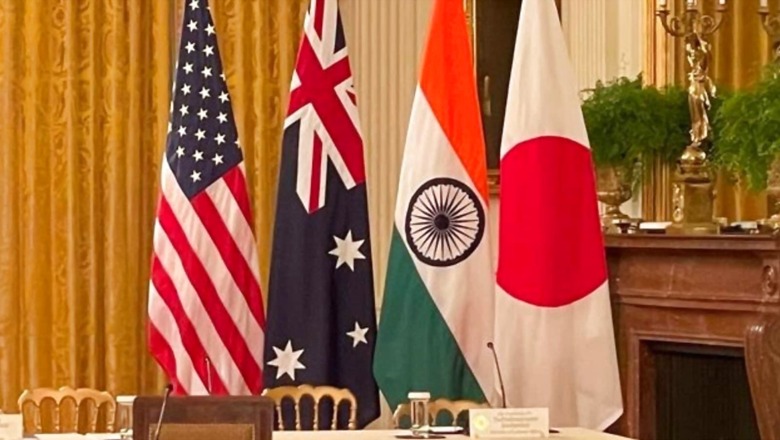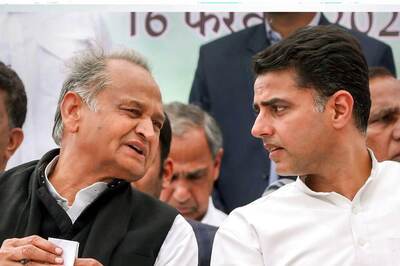
views
During Narendra Modi’s trip to the United States, especially leading up to the Quad Leaders’ summit, TV punditry and foreign policy discourse in India revolved largely around two questions—whether AUKUS is a “death blow” to the Quad and whether India has been “sidelined” by the US after Washington decided to give nuclear submarine technology to Australia via a trilateral security arrangement called AUKUS, also involving the UK. What added to the confusion is that everyone had a seemingly clear idea of what the AUKUS pact was and an equally foggy notion about the Quad.
The grouping of four Indo-Pacific democracies was being defined in negation—by what it wasn’t, not what it was. Though not exactly written off, it was suggested that with the development of a new security alliance between treaty allies focused on Indo-Pacific, Quad is now a diluted talk-shop relegated to discuss “issues like climate change, COVID-19 vaccines and the like.” What had presumably started as an anti-China coalition has now adopted an agenda that was deemed too broad for its own good and spread too thin to make an impact.
The Quad may struggle to meet the mountain of ever-changing expectations placed on its shoulders but readings of its inefficacy gloss over the incredible distance the coalition has covered since its resurrection in 2017. Even last year, a meeting of Quad heads of state was out of the question, there were no joint statements or even a mention of the word ‘Quad’ in the readouts released by India and Japan.
The first ‘in-person’ leaders’ summit in Washington DC on September 24 showed that the four Indo-Pacific democracies of India, Australia, Japan and the US are on surer footing, walking in lockstep to reveal an agenda that is as vast as the geographical span of Indo-Pacific that they represent.
It was also evident that they are playing the long game, expanding, deepening, intensifying and coordinating their actions across a range of sectors including maritime security, vaccine manufacturing and distribution, global health security financing, science and technology, genomic surveillance, climate crisis mitigation through multiple policy interventions, clean and renewable energy, supply chain of critical and emerging technologies, 5G technology, cyber security, infrastructure building and collaboration in space, to just name a few.
ALSO READ | An Idea Whose Time Has Come: A Quad Bank That Counters China’s Debt Trap
And yet, despite the broad expanse of their shared vision for the future of Indo-Pacific, the leaders’ summit also showed that Quad at its core remains a balancing coalition—is driven by collective anxiety over the China challenge and its willingness to shape Beijing’s behaviour. The name China is never mentioned, but it is omnipresent throughout the length and breadth of the joint statement and other documents.
For instance, the very second paragraph of the lengthy joint statement announces categorically that the members “recommit to promoting the free, open, rules-based order, rooted in international law and undaunted by coercion, to bolster security and prosperity in the Indo-Pacific and beyond” and adds that “we stand for the rule of law, freedom of navigation and overflight, peaceful resolution of disputes, democratic values, and territorial integrity of states. We commit to work together and with a range of partners.”
Or take the paragraph towards the end, that defines as a “force for regional peace, stability, security, and prosperity” and adds, “towards that end, we will continue to champion adherence to international law, particularly as reflected in the UN Convention on the Law of the Sea, to meet challenges to the maritime rules-based order, including in the East and South China Seas.”
China informs every action undertaken by the Quad. However, the countries have taken the ‘positive agenda’ approach to preserve a rules-based order and restore the balance of power in the Indo-Pacific. Instead of painting itself as an ‘anti-China clique’ — and lending itself vulnerable to Chinese efforts to paint the grouping as such — Quad has very smartly laid out what it stands for, what it plans to implement and how it stands as a “force for the good” in providing a better alternative.
The Quad is telling all Indo-Pacific nations that they need not become client states to an autocratic nation that promotes a ‘might-is-right’ framework to replace a rules-based order—that they always have a choice. A better choice for themselves and their people.
In laying out such an ambitious agenda spanning almost every sphere of 21st-century progress, and in attempting to shape the rules, set the standards, manage the emerging expectations and tackle the current realities of the Indo-Pacific region, the Quad has differentiated itself from treaty-based alliances such as AUKUS or even NATO that are defined through their specificity—such as collective security.
This isn’t to say that the Quad will get everything right. It still must match its actions to words when it comes to deliverables, but the grand agenda of Quad may only work in the flexible multilateral framework that defines the grouping. As long as the Quad remains nimble-footed and free of constricting ideological or geopolitical shackles and allows member states the leeway to move at their own pace, it will work.
ALSO READ | In Quad’s Semiconductor Gambit against China, India Stands to Gain
Comparisons with AUKUS, therefore, are useless. The trilateral security alliance was conceived to address a key Australian vulnerability. The eight nuclear-powered submarines that Canberra may get under the pact, will, as Mathieu Duchâtel of Institut Montaigne points out, enable Australia to project its power “in the South China Sea and the Taiwan Strait, with the ambition to influence China’s future strategic calculations. In other words, acquiring SSNs places the Australian Navy at the heart of the new deterrence posture that the United States is building in the Indo-Pacific.”
And yet this tangibility is also what defines AUKUS and restricts its scope, unlike the much broader agenda of the Quad. The grouping, for instance, has announced a series of initiatives in the areas of Covid and global health, infrastructure, clean-hydrogen partnership as part of climate action, green shipping network, a ‘Quad Fellowship’ programme where 100 students per year—25 from each Quad country—will pursue higher studies at STEM graduate universities in the US.
On vaccines, an issue that may make a huge difference worldwide, India has announced that it will resume exports beginning October 2021. As the joint statement declares: “Through $3.3 billion in the COVID-19 Crisis Response Emergency Support Loan program, Japan will continue to help regional countries to procure safe, effective, and quality-assured vaccines. Australia will deliver $212 million in grant aid to purchase vaccines for Southeast Asia and the Pacific. In addition, Australia will allocate $219 million to support last-mile vaccine rollouts and lead in coordinating the Quad’s last-mile delivery efforts in those regions.”
The Quad nations have made repeated overtures to a sceptical ASEAN, cognizant of the east Asian nations’ collective fear that they are being made to choose. And yet, for all the flowery language in the joint statement aimed at ASEAN —Quad nations know that it is only the timely delivery of effective vaccines that may change the equation in its favour.
The Quad’s other big announcement has been the announcement of ‘Quad Principles on Technology Design, Development, Governance, and Use’ that “affirm that the ways in which technology is designed, developed, governed, and users should be shaped by our shared democratic values and respect for universal human rights.” The statement released post leaders’ summit makes it clear that technology should support universal values, build trust, integrity, and resilience and foster healthy competition and international collaboration to advance the frontiers.
Towards this end, the Quad nations have established cooperation on critical and emerging technologies and are “mapping the supply chain of critical technologies and materials, including semiconductors”. They have also pledged “positive commitment to resilient, diverse, and secure supply chains of critical technologies, recognizing the importance of government support measures and policies that are transparent and market-oriented.”
This is not bureaucratic mumbo-jumbo (Quad doesn’t even have a secretariat or any headquarter as the NATO does in Brussels) but evidence of practical cooperation between four democracies to offer solutions for challenges arising out of China’s whole-of-government push to achieve dominance in this field. The Quad’s action suggests that the Indo-Pacific democracies are unwilling to let China exert control over the future of emerging and critical technologies such as semiconductors or 5G.
Similarly, on infrastructure—another key area which China seeks to dominate—there is a welcome movement towards aligning Quad’s efforts with G7 and EU. The joint statement announces that “we are launching a new Quad infrastructure partnership. As a Quad, we will meet regularly to coordinate our efforts, map the region’s infrastructure needs, and coordinate on regional needs and opportunities. We will cooperate to provide technical assistance, empowering regional partners with evaluative tools, and will promote sustainable infrastructure development.
“We support the G7’s infrastructure efforts, and look forward to cooperating with like-minded partners, including with the EU. We reconfirm the G20 Quality Infrastructure Investment Principles and will reenergize our efforts to provide high-standards infrastructure in the Indo-Pacific. We reaffirm our interest in continuing our engagement with the Blue Dot Network.”
In space, another domain where China is rapidly building offensive and defensive capabilities, Quad nations say they will “identify new collaboration opportunities and share satellite data for peaceful purposes such as monitoring climate change, disaster response and preparedness, sustainable uses of oceans and marine resources, and on responding to challenges in shared domains.” China’s ambition also includes electronic and cyber warfare, leading the Quad to “begin new cooperation in cyber space and pledge to work together to combat cyber threats, promote resilience, and secure our critical infrastructure.”
It will be wrong to assume that Quad’s pledges have only been reactive. In the area of climate action, Quad countries have a forward-looking agenda, organizing their efforts across “three thematic areas—climate ambition, clean-energy innovation and deployment, and climate adaptation, resilience and preparedness, with the intent to pursue enhanced actions during the 2020s, contributing to the aim of achieving global net-zero emissions preferably by 2050, and taking into account national circumstances.”
What we see here is that the Quad is aiming to build resilience and capabilities in the region that has become a staging ground for great power rivalry.
ALSO READ | With Quad 5G Plan, India Will Be at the Centre of Fostering Global Technology Innovation
As Brookings Institution scholar Tanvi Madan points out, the countries are “building resilience in the region, whether in the maritime, economic, technology, health or climate domains…Members outlined their approach to this, including understanding vulnerabilities, information sharing, offering alternatives, building capacity, setting higher standards, and innovating. This emphasis is designed to convey a desire to strengthen both Quad members’ and other countries’ ability to deter, detect, and defend against challenges, and, more positively, to add value in the region.”
And the very broadness, intangibility and diffusion that Quad is accused of may allow it to navigate future challenges better. Its flexible framework may allow it to survive cycle of history and inevitable shifting of geopolitical tectonic plates—a nimbleness that is lacking in a security-focused alliance like NATO, the result of which is evident before us.
The entire AUKUS kerfuffle arises from the breach of trust between members of the transatlantic alliance, revealing the underlying tensions among treaty members who came together to mitigate the challenge posed by the USSR during Cold War. With the evaporation of the Soviet threat, NATO has lost its raison d’être. No amount of bureaucratic framework or pledges from its members may restore it.
As opinion polls suggest, NATO is now torn between two conflicting churns. For an alliance that was predicated on collective security via Article Five, “majorities in most European nations already oppose the use of their troops to aid a NATO ally” but believe that “NATO is a device to ensure US protection for them rather than a collective alliance whereby all support all.” These findings should be seen with another set of polls that reveal that despite the US marking out China as an existential threat and expecting NATO allies “to shoulder some of the burden in a de facto anti-Chinese alliance”, Europe wants to have none of it. As Washington Post points out in its report, “a January 2021 poll from the European Council on Foreign Relations found 60 percent of Europeans want their nation to remain neutral in any conflict between China and the US.”
This lies behind the marginalization of NATO, if not the end of a framework that French president Emmanuel Macron had declared as “brain dead” two years back. The manifestation of these tensions is revealed periodically in events such as US troop withdrawal from north-eastern Syria, Nord Stream 2 crisis, EU-China investment deal or the AUKUS rumpus.
This is where the Quad is playing a longer game. It seems inconceivable now to predict the collapse of CCP regime in China, but history is littered with instances of imperial hubris. Leaving clairvoyance aside, even in absence of a China challenge, however, the Quad likely won’t experience the kind of existential crisis that NATO is going through. It is a measure of what democracies can do if they put their minds together, and as Prime Minister Modi said at the UNGA, democracies can and have delivered.
Read all the Latest News , Breaking News and Ukraine-Russia War Live Updates here.




















Comments
0 comment